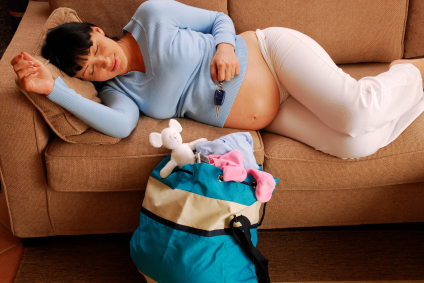Once upon a time, I was a Labor and Delivery Room (L&D) nurse at the University of Cincinnati Medical Center. It was probably one of my most favorite places to work because I truly loved supporting moms (and dads or other significant family members) through their birth experience and felt that each baby born was a miracle.
Working in L&D was a challenge, as you were actually caring for two patients at once (mom and baby-to-be). Also, at that hospital at that time, most of the women admitted were high risk due to chronic illnesses, pregnancy induced problems — such as diabetes or preeclampsia, carrying multiples (twins, triplets or more!), or lacked prenatal care. But whatever the situation, the glory in the whole experience was that most of the deliveries brought healthy babies into the world. LOVED THAT!
Because of my experience, I have been asked over the years by friends to be their labor coach as well as by my daughter to be with her and my wonderful son-in-law in the delivery room. Two of my post L&D coaching experiences were for the delivery of twin and all the women I coached had scheduled C-sections.
The reason I mention this is because many new mothers expressed to me over the years that they wished they had additional information before their C-section birthing experiences. They felt that once they got to the hospital, they lost their ability to make the birthing experience their own. It became more medicinal and surgical rather than personal, despite the effort of the hospital to provide rooms that looked like home and with nurses who were dedicated to ensuring a happy outcome.
Based on all the knowledge I’ve gained over the years, I compiled a list of things for moms-to-be to think about before their delivery, along with some items they may want to bring to the hospital. While this list is dedicated mostly to moms who are having a scheduled C-section, it is relevant for all moms having a hospital delivery. There are lots of lists available online and through your doctor with information on what to pack and bring with you that are much more comprehensive, but these are a few helpful extras you may not think about ahead of time:
IN THE HOSPITAL, BEFORE THE DELIVERY ROOM
1. We Want Scrubs
Have whoever is going to be in the delivery room cued to ask to have their scrubs, or delivery room attire, brought to them early. The reason I mention this is, sometimes things get rushed after the mother is brought into the delivery room and then someone, last minute, remembers to get the support person ready. This can take a few minutes and some of what is happening may be missed. Importantly, the mom will have less time without her support person dedicated to her.
2. Timing Is Everything
All C-sections require that the mom-to-be have a urinary catheter. Ask to have your urinary catheter placed once you have had your local anesthesia; which will, most likely be either a spinal or an epidural. Unfortunately for my daughter, her catheter was put-in before the anesthesia and it scared her as she was not comfortable feeling the insertion. After, my daughter asked the nurse to then allow me in to be with her so I — Mama Bear, in a gentle and kind yet assertive way — could help control what was best for her while assisting the experienced and capable nursing staff in the right way. I think I accomplished that, but didn’t ask for an evaluation from the staff!
3. Stay Calm and Carry Lotion
Consider bringing your favorite lotion into the pre-delivery room. There can be some wait time before everything gets started and dimming the lights along with a massage from your support person can be relaxing and distracting.
IN THE DELIVERY ROOM
1. All Eyes on Baby
Eye drops are placed in the baby’s eyes to prevent eye infections, such as Chlamydia and gonorrhea, which can cause blindness. Many states require that all babies receive the drops. When I was in L&D, silver nitrate was used, which caused the baby discomfort so he or she closed its eyes. Today, some hospitals use a milder eye drop, Erythromycin. Ask your health care professional (HCP) which type of drop is used in the hospital you will be using. If it is silver nitrate, ask if you can bond with the baby before the eye drops are placed. Most state laws allow for the HCP to determine timing, so eye drop insertion can wait until an hour after delivery. Even with a C-section, it is still possible to hold the baby and gaze into its beautiful eyes and bond. In fact, some mothers will be able to breastfeed, even while the surgery is being completed, so check with your HCP, if you are interested.
2. Select Tunes to Set the Mood.
Consider bringing your own music into the delivery room. This way, YOU can create the mood of the delivery. Again, it is best to ask the hospital staff first to ensure they are prepared for your request. However, there is no doubt that your baby has been listening to your favorite tunes for months and will find the mood familiar and peaceful, along with you.
3. Play by Play
Ask your HCP if one of the nurses or the anesthesiologist/nurse anesthetist can do a running commentary as the surgery is taking place. I know many people who have found it reassuring to hear what is going on, especially those who don’t want to watch in the mirror. Your HCP can give you guidance on who is in the best position to offer this information. Some fathers want to do this, especially if this is a second delivery. Others fathers are doing the best they can to hold your hand — and not to pass out; sorry, but it’s true!
4. Picture This
Have your support person bring a small camera to take photos (or video) in the delivery room of the newborn(s) and your first bonding experience. One of the staff may be able to take a photo or two with the camera. However, I can’t imagine the staff having the time to fill in and be the videographer.
AFTER DELIVERY
1. Room for Recovery
Depending on the hospital, you will be in a recovery room after your delivery for an hour or two. If you want your family there, asking before hand can help you avoid disappointment after the fact.
2. Gifts that Keep on Giving
Have a gift for the father or your significant support person, as well as any brothers or sisters, ready in your carry-to-the-hospital bag. Gifts for the children could be big brother or sister t-shirts and for others, something small but meaningful. It will show your appreciation and make them feel special because of the recognition.
3. Support
Ask your HCP if there is a belly binder you can use for belly support, like the Tauts Post-Pregnancy Wrap. If so, bring it. If not, remember to use a pillow over your suture line to cough and deep breathe as it can support you and minimize the discomfort.
4. Walk it Out
I know this isn’t something to bring with you, but I strongly recommend that you walk as much as allowed and drink lots of water. Both go a long way in speeding up your recovery and reducing complications.
5. Pads, pads, pads!
Being one of the Always women’s health experts, that is the pad brand that I know the most about. I read all the time that women prefer Always infinity as the pad that is most comfortable after they deliver, either vaginally or by c-section. There is a reason why Always Xtra Protection Liners with Odor Lock and Always Infinity just received Modern Mom’s first-ever Seal of Approval!
Lastly, as I said at the beginning, this is a not an all-encompassing list of what you should think about before delivery, during or after. No doubt many of you have your own suggestions to add.
Elaine Plummer is a health expert for Always and Tampax.





